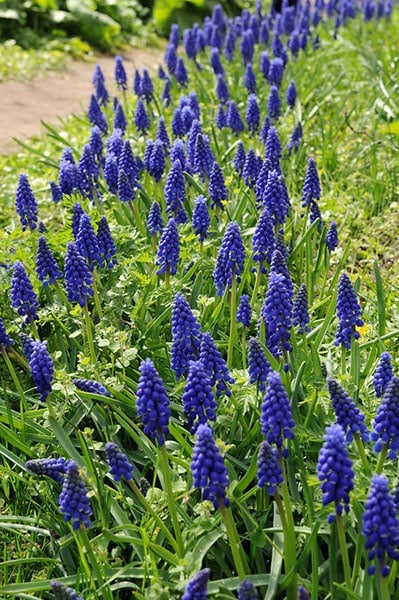Found this copy of an old painting of Napoleon and Josephine, his first wife . . .

Found this copy of an old painting of Napoleon and Josephine, his first wife . . .

Yesterday afternoon, my friend Sheila came by for a visit. She was the first live visitor since the beginning of the Pandemic. I served lemonade with ice and sliced strawberries on the courtyard . . .

. . . and we talked about gardens — what else, with mine spread out behind us? Here a rhododendron is coming into full bloom.

She and her husband are incorporating more perennials and roses into their back yard landscape. I steered her to peonies and the Old Roses for their stability and endurance in our harsh winters, such as the Rose of Castile, r. damasceno bifera. Cicero’s favorite at his villa on the Via Appia, it’s my oldest rose, dated c. 50 B.C.E.

Next is the “Red Rose of Lancaster,” a gallica dated c. 1370, sometimes referred to as the apothecary’s rose, r. gallica officianalis. This red rose was first adopted as a heraldic badge by John of Gaunt, first Duke of Lancaster and father of King Henry IV, the first Lancastrian king. I grow this cultivar in my herb garden in honor of my English ancestors who were loyal Lancastrians in the Wars of the Roses.
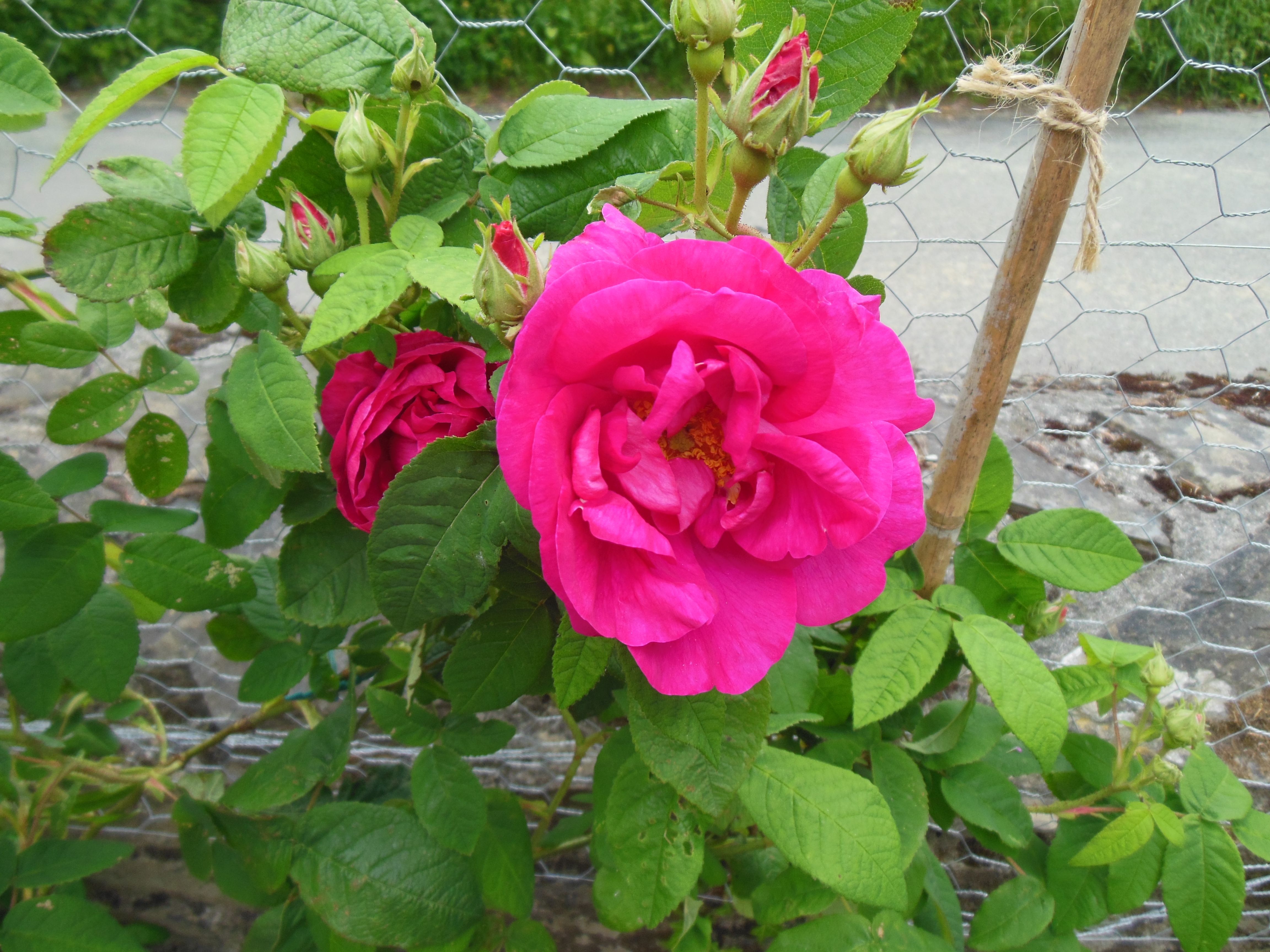
A couple of French roses round out my old rose collection, one of which is also part of the herb garden, the Empress Josephine. This cultivar is descended from a pink gallica stock at Malmaison, dated prior to 1815, and developed by David Austin.

The second French rose in my garden (in a separate location) is “Queen of the Bourbons.” Bred by Mauget (France, 1834), it is considered one of the heirloom roses. When in full bloom, the bush is covered with rounded pink cups packed with 26-40 petals.

These are a few of my favorite May bloomers showcased in this week’s “Six on Saturday.” Only the rhododendron is in full bloom, but all the roses have sprouted buds, some showing color already. Next week, I’ll feature the Old-Fashioned roses. Be sure to tune in then!
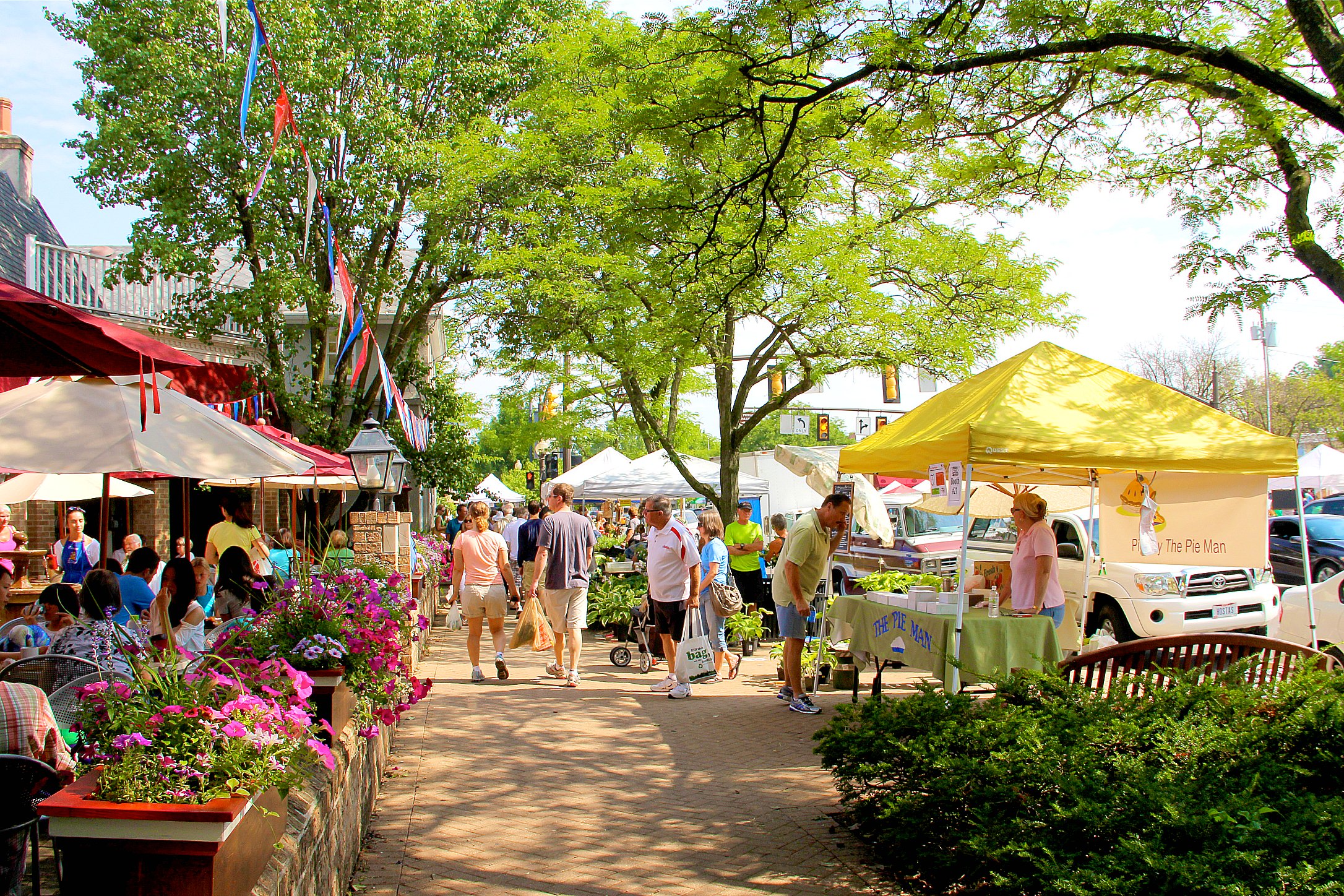
At least, that’s how I remember the old Burl Ives folk song from my Southern childhood. Actually, the lyrics featured cigarette trees, an altogether different species that grows “where hens lay soft-boiled eggs.” The flowers do resemble small cigarettes and look rather ugly, if you ask me.
Cottonwood trees, on the other hand, are rather graceful and willowy, with heart shaped leaves and, depending upon the specific type, resemble birches or poplar trees.

Before the merry month of May, cottonwoods produce a sweet fragrance before anything blooms in my garden. The scent wafts on the air from trees miles away, emitted by flavonoids in the sticky sap within the tree’s buds that coats the leaves of cottonwood as they unfurl, protecting them against insects eager to attack the first fresh leaves of the year.

When those buds burst, they shed white seed-bearing white fluffs delicate as goosedown . . .

. . . that float as much as 20 miles on spring breezes. The seeds will sprout within 24 hours of hitting the ground.

And if fallen fluff becomes a thick enough accumulation, the ground can look like a snow-covered garden . . .
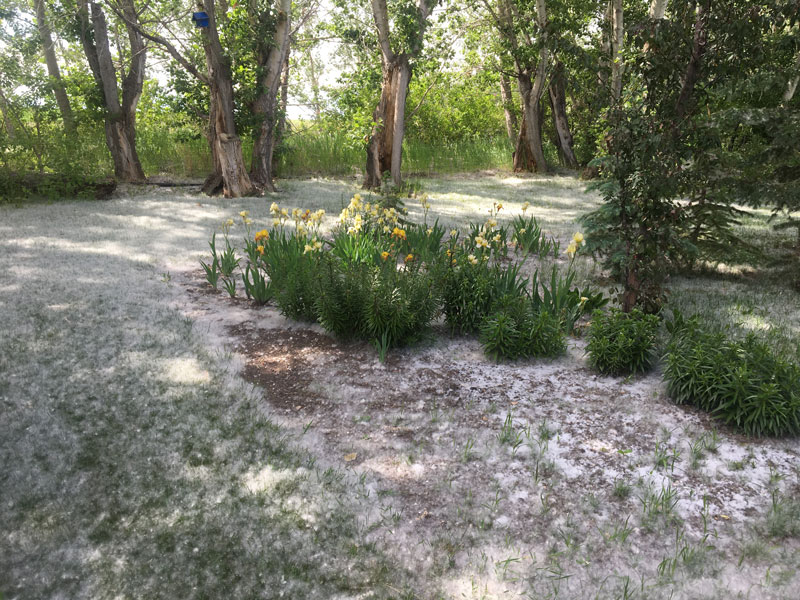
. . . but a good rainfall should wash away all this faux snow, I think. Fortunately, no cottonwoods grow that close to our own residential area. Nonetheless, when those first tiny will o’ wisps float around my head when I’m outside, I invariably “hear” ole Burl Ives singing in my memory.
Oh, the buzzin’ of the bees in the cottonwood trees . . .
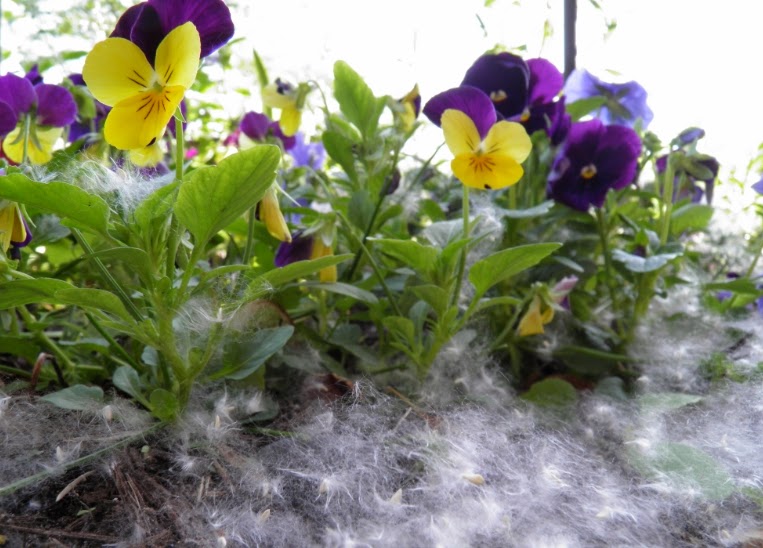

During a warming spell in March, when our favorite locally owned garden nursery opened up, I collected an assortment of fillers and spillers and two thrillers for my patio urns. The fillers, pansies and violas, are still going strong along with wire vine plants. Not so the bicopa spillers and miniature dracena thrillers. A couple of sub-freezing nights here and there took care of them in spite of a covering of old linen dishtowel.
Was I rushing the season? After forty-plus years in Eastern Washington state, this transplant from the Deep South still hasn’t learned her horticultural zoning lessons!

Since wire vine plants are trailers as well as ground creepers, I like to add a couple of these spillers to pots and urns for delicate grace notes, along with trailing vinca and creeping Charlies. This year I want to try stuffing one into an otherwise unsightly broken front walk, like this:

So what’s next? Pink Geraniums thrillers with a variety of spillers such as blue and white bicopa (fresh plants) . . .
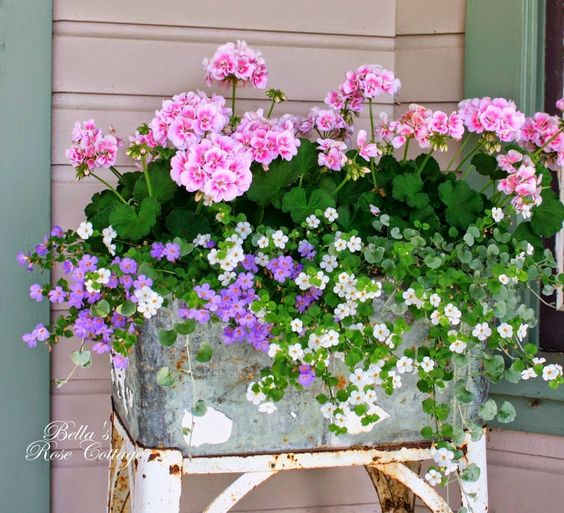
or “Diamond Frost” Euphorbia fillers . . .

. . . shown here with overgrown spillers Dichondra “Silver Falls” for the front porch urns flanking my white Luytens bench.
On second thoughts, perhaps I’d better wait until May 30. What do you think?

2. Their long, slender foliage and white seed pods, however, will add grace notes to the edges of the bed. By summer, they’ll have popped those black seeds “to make more of their kind” (Genesis 1:12).
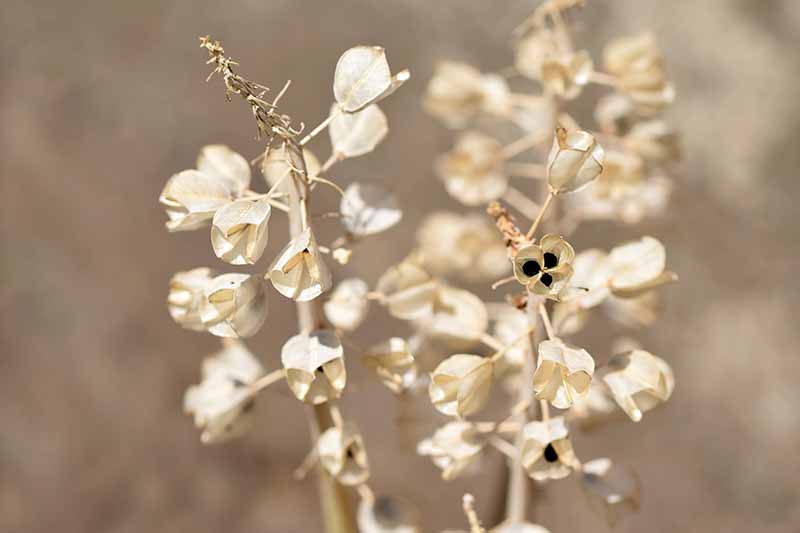
3. Crocuses are long gone.
4. Russian sage foliage is emerging from winter hibernation.
5. Soon this perennial shrub will look like this, and honey bees will buzz from one tiny blossom to another. They won’t mind when I pass by on my way to see what the postman brought.

5. Violets are going strong here as ground cover under larger plants and especially in my herb garden where they edge the brick walks. Forty years ago, I dug up a handful of wild violets from the woods. Today they continue to spread by underground rhizomes and seeds spat out by cleistogamous or non-opening flowers at ground level. Yes, some land in the lawns! I’ve thinned out a number of areas, packed damp plants with their soil attached, and shipped them to my daughters as a little pieces of home.
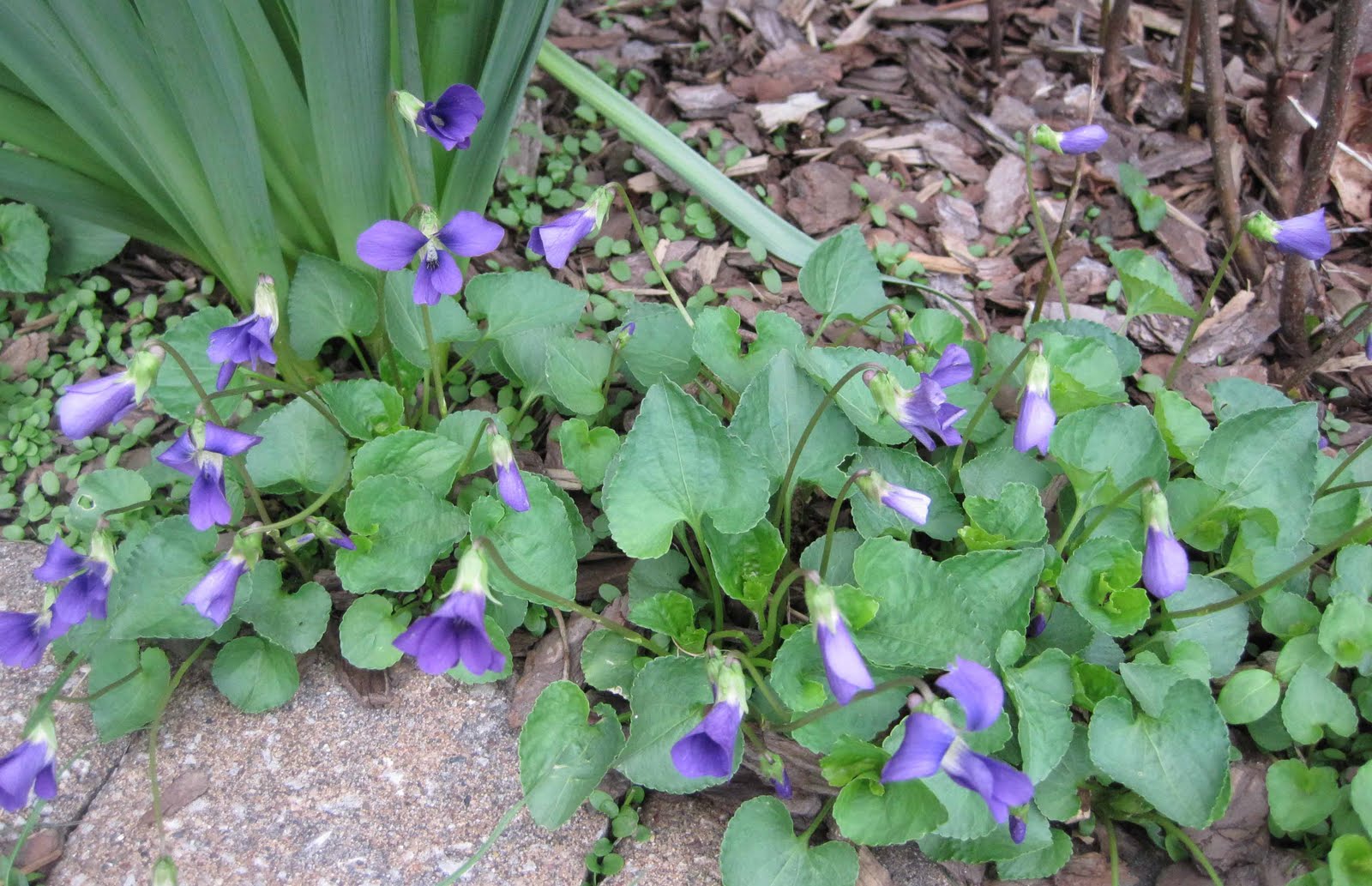
6. Bearded irises will have to wait a bit longer, closer to peony season in a few weeks.

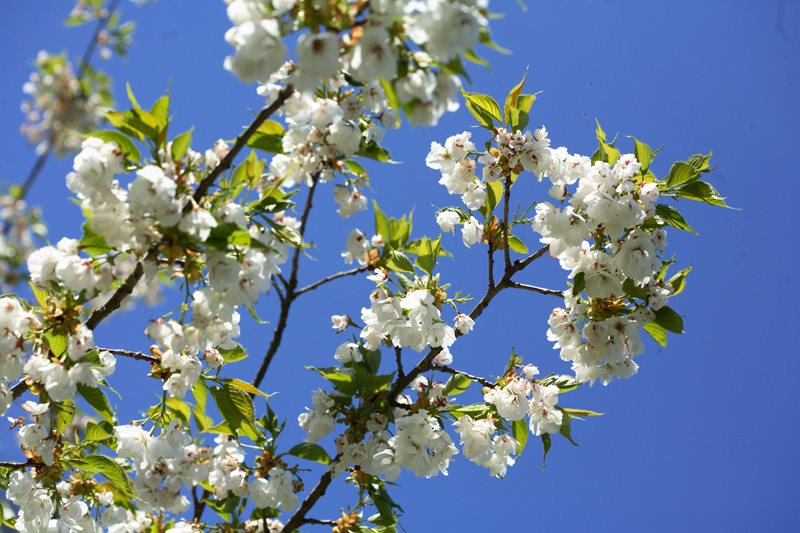

Actually, these aren’t real grapes. They just look like them — upright clusters of tiny grapes, usually in shades of blue or purple, sometimes white, depending upon their particular variety. Blue hyacinths line the edges of my front entrance beds on both sides of the driveway. They offer a delightful contrast to the yellow and white tulips currently taking the place of earlier crocuses.
The genus Muscari derives from the Greek word for musk, a perfume fixative used for its persistently heavy scent. If we play with this Greek derivative, we discover Muscadine (c. 1785), a Southern grape with small clusters that smell like musk.

My father’s Scuppernong grapes, a great favorite in the South, were a muscadine variety. Yes, he did produce a sweet homemade wine.
Muscat (c. 1548) is any of several cultivated grapes used for making wines and raisins.

Muscat Canelli is one of my favorite white wines that have become rather hard to find, even before the Pandemic.

Muscatel, from Old French muscadel and Middle English muskadell, is both a sweet fortified wine and a variety of raisin.

Getting a bit dizzy over all these varietals? We’ve wandered too far from the hyacinth bulb genus, muscari. The particular variety in my garden is the Muscari armeniacrum, among the more common found home gardens. They tend to spread and, if allowed free reign, will naturalize in other areas, even the lawn. Some are taking over the path to the front gate arbor. After they finish their bloom and begin to go dormant in late summer, I’ll dig those up and transplant them back into the edging, three inches deep.
